Problem Statement
The decision has been made to use “Percentage of cluster resources reserved for HA” admission control setting, and use Strict admission control to ensure the N+1 minimum redundancy level is maintained. However, as most virtual machines do not use “Reservations” for CPU and/or Memory, the default reservation is only 32Mhz and 0MB+overhead for a virtual machine. In the event of a failure, this level of resources is unlikely to provide sufficient compute to operate production workloads. How can the environment be configured to ensure a minimum level of performance is guaranteed in the event of one or more host failures?
Requirements
1. All Clusters have a minimum requirement of N+1 redundancy
2. In the event of a host failure, a minimum level of performance must be guaranteed
Assumptions
1. vSphere 5.0 or later (Note: This is Significant as default reservation dropped from 256Mhz to 32Mhz, RAM remained at 0MB + overhead)
2. Percentage of Cluster resources reserved for HA is used and set to a value as per Example Architectural Decision – High Availability Admission Control
3. Strict admission control is enabled
4. Target over commitment Ratios are <=4:1 vCPU / Physical Cores | <=1.5 : 1 vRAM / Physical RAM
5. Physical CPU Core speed is >=2.0Ghz
6. Virtual machines sizes in the cluster will vary
7. A limited number of mission critical virtual machines may be set with reservations
8. Average VM size uses >2GB RAM
9. Clusters compute resources will be utilized at >=50%
Constraints
1. Ensuring all compute requirements are provided to Virtual machines during BAU
Motivation
1. Meet/Exceed availability requirements
2. Minimize complexity
3. Ensure the target availability and performance is maintained without significantly compromising over commitment ratios
Architectural Decision
Ensure all clusters remain configured with the HA admission control setting use
“Enable – Do not power on virtual machines that violate availability constraints”
and
Use “Percentage of Cluster resources reserved for HA” for the admission control policy with the percentage value based on the following Architectural Decision – High Availability Admission Control
Configure the following HA Advanced Settings
1. “das.vmMemoryMinMB” with a value of “1024″
2. “das.vmCpuMinMHz” with a value of “512”
Justification
1. Enabling admission control is critical to ensure the required level of availability.
2. The “Percentage of cluster resources reserved for HA” setting allows a suitable percentage value of cluster resources to reserved depending on the size of each cluster to maintain N+1
3.The potentially inefficient slot size calculation used with “Host Failures cluster tolerates” does not suit clusters where virtual machines sizes vary and/or where some mission Critical VMs require reservations
- 4.
- Using advanced settings “das.vmCpuMinMHz” & “das.vmMemoryMinMB” allows a minimum level of performance (per VM) to be guaranteed in the event of one or more host failures
- 5.
- Advanced settings have been configured to ensure the target over commit ratios are still achieved while ensuring a minimum level of resources in a the event of a host failure
- 6.
- Maintains an acceptable minimum level of performance in the event of a host failure without requiring the administrative overhead of setting and maintaining “reservations” at the Virtual machine level
- 7.
- Where no reservations are used, and advanced settings not configured, the default reservation would be 32Mhz and 0MB+ memory overhead is used. This would likely result in degraded performance in the event a host failure occurs.
Alternatives
1. Use “Specify a fail over host” and have one or more hosts specified
2. “Host Failures cluster tolerates” and set it to appropriate value depending on hosts per cluster without using advanced settings
3.Use higher Percentage values
4. Use Higher / Lower values for “das.vmMemoryMinMB” and “das.vmCpuMinMHz”
5. Set Virtual machine level reservations on all VMs
Implications
1. The “das.vmCpuMinMHz” advanced setting applies on a per VM basis, not a per vCPU basis, so VMs with multiple vCPUs will still only be guarenteed 512Mhz in a HA event
2. This will reduce the number of virtual machines that can be powered on within the cluster (in order to enforce the HA requirements)



